一个基于修改后的Logistics映射的图片加密方案-外文翻译
基于改进Logistic映射的图像加密算法
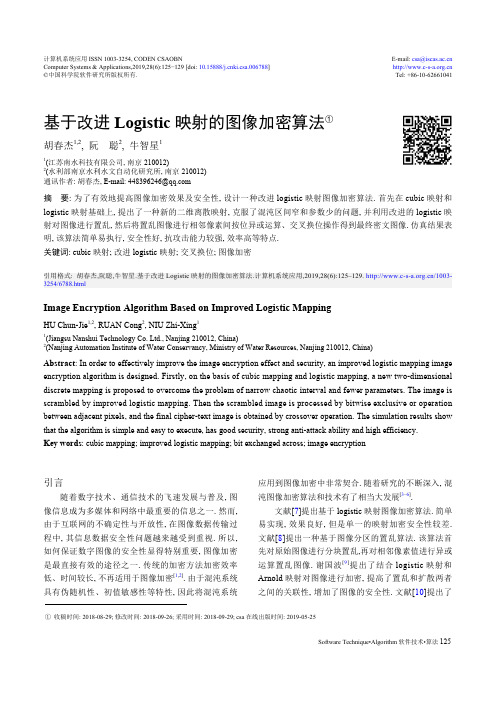
引言
随着数字技术、通信技术的飞速发展与普及, 图 像信息成为多媒体和网络中最重要的信息之一. 然而, 由于互联网的不确定性与开放性, 在图像数据传输过 程中, 其信息数据安全性问题越来越受到重视. 所以, 如何保证数字图像的安全性显得特别重要, 图像加密 是最直接有效的途径之一. 传统的加密方法加密效率 低、时间较长, 不再适用于图像加密[1,2]. 由于混沌系统 具有伪随机性、初值敏感性等特性, 因此将混沌系统
引用格式: 胡春杰,阮聪,牛智星.基于改进 Logistic 映射的图像加密算法.计算机系统应用,2019,28(6):125–129. /10033254/6788.html
Image Encryption Algorithm Based on Improved Logistic Mapping
计算机系统应用 ISSN 1003-3254, CODEN CSAOBN Computer Systems & Applications,2019,28(6):125−129 [doi: 10.15888/ki.csa.006788] ©中国科学院软件研究所版权所有.
E-mail: csa@ Tel: +86-10-62661041
Abstract: In order to effectively improve the image encryption effect and security, an improved logistic mapping image encryption algorithm is designed. Firstly, on the basis of cubic mapping and logistic mapping, a new two-dimensional discrete mapping is proposed to overcome the problem of narrow chaotic interval and fewer parameters. The image is scrambled by improved logistic mapping. Then the scrambled image is processed by bitwise exclusive or operation between adjacent pixels, and the final cipher-text image is obtained by crossover operation. The simulation results show that the algorithm is simple and easy to execute, has good security, strong anti-attack ability and high efficiency. Key words: cubic mapping; improved logistic mapping; bit exchanged across; image encryption
一种基于Logistic映射的图像加密算法
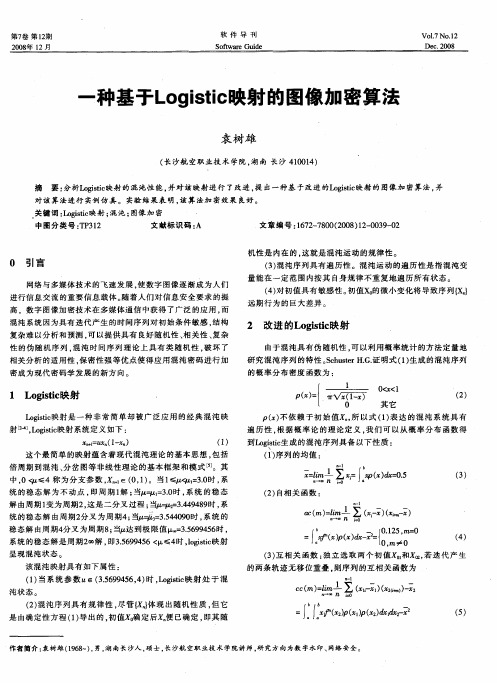
p = 、 (){霄 / 【
f— — — — 一
0
0 】 <<
其 它
() 2
p( ) 依 赖 于初 始 值 。所 以式 ( ) 达 的混 沌 系统 具 有 不 , 1表 遍 历性 , 根据 概 率论 的理论 定 义 , 我们 可 以从 概 率分 布 函数 得 到L gs c 成 的混沌 序列 具备 以下 性质 : oit 生 i
第 7 第 l 期 卷 2
2 0年 1 08 2月
软 件 导 刊
So t r fwa eGl d l e i
VO1 .2 . No 1 7 De . 0 C 2 o8
一
种基于L gsi映射 的图像加密算法 o it c
袁树 雄
( 长沙航 空职 业技 术 学院 , 南 长沙 4 0 1 ) 湖 1 0 4
(’ 列 的均值 : 1序 )
_ - ∑ f (a0 n k 5 - I ):
.
() 3
() 2 自相 关 函 数 :
a( = c m)
l i m1
一
统 的稳态 解 由周 期2 叉 为周 期4 当/ ̄335 4 9 时 , 分 ; a = .4 0 0 系统 的 , 稳 态解 由周 期4 叉为 周期 8 当 达 到极 限值 = .6 9 5 时 , 分 ; 35 9 4 6
高 ,数字 图像 加密技 术在 多媒 体通 信 中获得 了广 泛 的应 用 , 而 混沌 系统 因为 具有迭 代产 生 的时 间序列 对初 始条 件敏 感 , 结构
2 改 进 的L gsi映 射 oi c t
由于混沌 具 有伪 随机性 , 以利用 概率 统计 的方 法定 量地 可
研究 混 沌序列 的特 性 。 c utr G. 明式 ( ) 成 的混沌 序列 S h se H. 证 1生
一个基于修改后的Logistics映射的图片加密方案-外文翻译
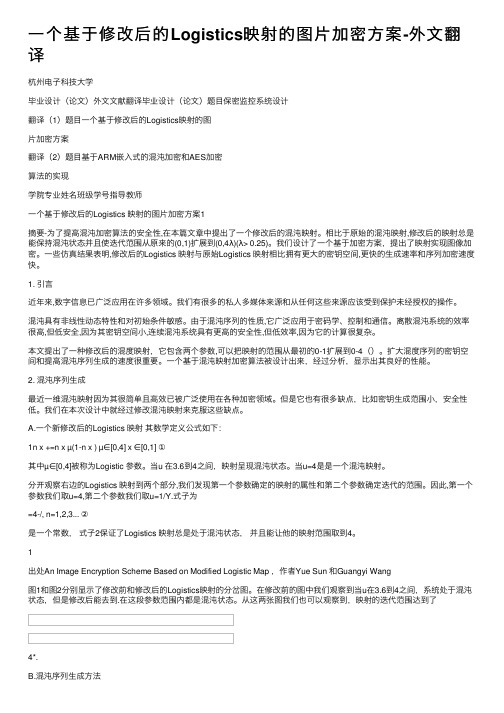
⼀个基于修改后的Logistics映射的图⽚加密⽅案-外⽂翻译杭州电⼦科技⼤学毕业设计(论⽂)外⽂⽂献翻译毕业设计(论⽂)题⽬保密监控系统设计翻译(1)题⽬⼀个基于修改后的Logistics映射的图⽚加密⽅案翻译(2)题⽬基于ARM嵌⼊式的混沌加密和AES加密算法的实现学院专业姓名班级学号指导教师⼀个基于修改后的Logistics 映射的图⽚加密⽅案1摘要-为了提⾼混沌加密算法的安全性,在本篇⽂章中提出了⼀个修改后的混沌映射。
相⽐于原始的混沌映射,修改后的映射总是能保持混沌状态并且使迭代范围从原来的(0,1)扩展到(0,4λ)(λ> 0.25)。
我们设计了⼀个基于加密⽅案,提出了映射实现图像加密。
⼀些仿真结果表明,修改后的Logistics 映射与原始Logistics 映射相⽐拥有更⼤的密钥空间,更快的⽣成速率和序列加密速度快。
1. 引⾔近年来,数字信息已⼴泛应⽤在许多领域。
我们有很多的私⼈多媒体来源和从任何这些来源应该受到保护未经授权的操作。
混沌具有⾮线性动态特性和对初始条件敏感。
由于混沌序列的性质,它⼴泛应⽤于密码学、控制和通信。
离散混沌系统的效率很⾼,但低安全,因为其密钥空间⼩,连续混沌系统具有更⾼的安全性,但低效率,因为它的计算很复杂。
本⽂提出了⼀种修改后的混度映射,它包含两个参数,可以把映射的范围从最初的0-1扩展到0-4()。
扩⼤混度序列的密钥空间和提⾼混沌序列⽣成的速度很重要。
⼀个基于混沌映射加密算法被设计出来,经过分析,显⽰出其良好的性能。
2. 混沌序列⽣成最近⼀维混沌映射因为其很简单且⾼效已被⼴泛使⽤在各种加密领域。
但是它也有很多缺点,⽐如密钥⽣成范围⼩,安全性低。
我们在本次设计中就经过修改混沌映射来克服这些缺点。
A.⼀个新修改后的Logistics 映射其数学定义公式如下:1n x +=n x µ(1-n x ) µ∈[0,4] x ∈[0,1] ①其中µ∈[0,4]被称为Logistic 参数。
基于改进Logistic映射的混沌图像加密算法设计
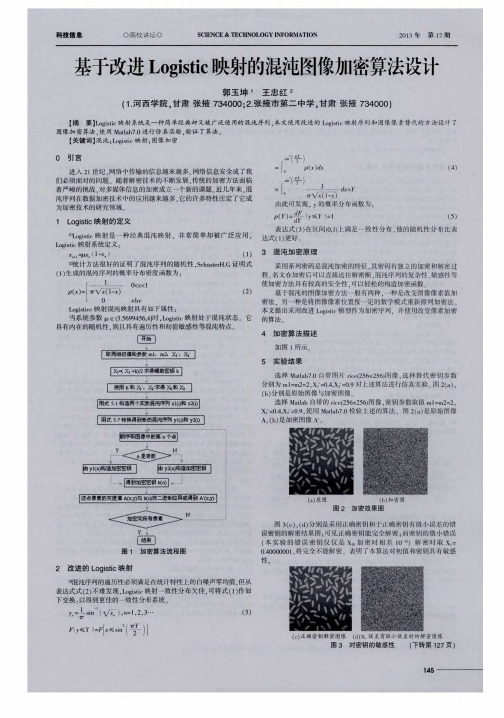
S I 2 e
3 8 1 4 m 2 5 . 5 8 1 9 m
l / 4 弦 线后掠角
翼尖弦长
I
x 。
e J
2 5 . 0 。
1 . 2 5  ̄m 3 . 0 1 9 7 m
后缘转折处弦长 : 表 2 翼梢小 翼几何 尺寸
表 1 机 翼 几 何 尺 寸
f 半展长 半机翼面积 根弦长 I J f 机翼 几何形 状 h i 2
.
5 结论
本文针对传统翼梢小翼仅针对飞机巡 航阶段设计所 存在的不足 . 设计 了一种伸缩栅格结构 .将其用于翼梢小翼 中可 实时改变其高度 . 优化飞机 的气动效率 通过 A V L 计算证 明 . 变高度翼梢小翼可使升力 系数提高 0 . 2 0 5 2 %. 并使诱导 阻力 系数降低 O . 5 6 7 %. 改善 了飞机在起
f
I 1 2 9 1 8 m
烈滚转或突然猛烈下降 . 小 型飞机甚至会翻滚坠地 。 变体翼梢小翼能有
效减弱 大型客机的 尾迹, 降 低放飞时间 间隔堤高机场 使用 效率。 l
【 参考文献】
[ 1 ] 唐登斌 , 钱 家祥 , 史 明泉 . 机翼翼尖装 置的应用和发 展Ⅲ. 南 京航空航 天大学 学报 . 1 9 9 4 . [ 2 ] 方保瑞 . 飞机气动布局设计f M 】 . 北京: 航空工业出版社 , 1 9 9 7 . [ 3 ] K i c h i o K I .A e r o d y n a m i c d e s i g n a n d a n a l y s i s o f w i n g l e t s[ J 1 l A I A A 7 6—
一种基于Arnold变换的彩色图像加密算法

一种基于Arnold变换的彩色图像加密算法一种基于Arnold变换的彩色图像加密算法摘要:随着信息技术的发展,图像已经成为信息表达的一种重要方式,人们对图像信息安全的要求也越来越高,图像的安全问题已成为信息安全的一个极其重要的研究领域。
为保证图像信息的安全传送,需要对图像做加密和解密处理,其中,基于Arnold变换的空间域置乱加密技术是比较成熟的加密技术,由于彩色图像具有三个分量,通过对彩色图像的三个分量分别进行不同参数的置乱,合成后可得到加密后的彩色图像。
实验结果表明,该算法实现简单,加密效果好。
Abstract:Along with the information technology development,the image has become an important way of information expression and security requirements are increasingly high,so image security has become a very important research field of the information security. In order to ensure the image information security transmission,image encryption and decryption are needed,and space domain scrambling and encryption technology based on Arnold transform is relatively mature. Because the color image has three components,by the scrambling of the differentparameters of the three components,it can obtain color image after encryption through synthesis. Experimental results show that the algorithm is simple to implement and the encryption effect is good.关键词:Arnold变换;空域置乱;彩色图像;加密Key words:Arnold transformation;spatial scrambling;color image;encryption中图分类号:TP309.7 文献标识码:A 文章编号:1006-4311(2016)13-0171-030 引言随着计算机和网络技术的发展,图像的安全问题已成为信息安全的一个极其重要的研究领域。
基于 Logistic 混沌映射的图像加密系统及 FPGA 实现
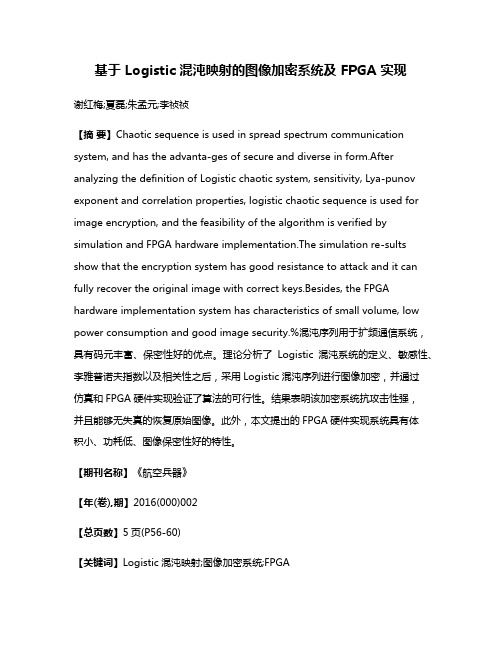
基于 Logistic 混沌映射的图像加密系统及 FPGA 实现谢红梅;夏磊;朱孟元;李祯祯【摘要】Chaotic sequence is used in spread spectrum communication system, and has the advanta-ges of secure and diverse in form.After analyzing the definition of Logistic chaotic system, sensitivity, Lya-punov exponent and correlation properties, logistic chaotic sequence is used for image encryption, and the feasibility of the algorithm is verified by simulation and FPGA hardware implementation.The simulation re-sults show that the encryption system has good resistance to attack and it can fully recover the original image with correct keys.Besides, the FPGA hardware implementation system has characteristics of small volume, low power consumption and good image security.%混沌序列用于扩频通信系统,具有码元丰富、保密性好的优点。
理论分析了Logistic混沌系统的定义、敏感性、李雅普诺夫指数以及相关性之后,采用Logistic混沌序列进行图像加密,并通过仿真和FPGA硬件实现验证了算法的可行性。
基于Logistic混沌加密和DWT的数字图像水印算法
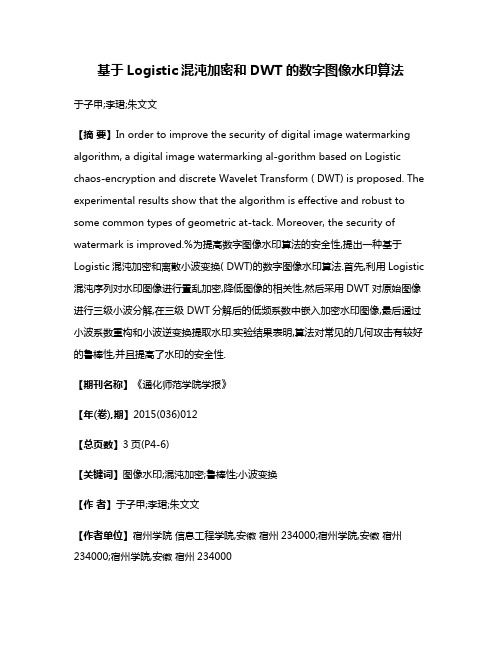
基于Logistic混沌加密和DWT的数字图像水印算法于子甲;李珺;朱文文【摘要】In order to improve the security of digital image watermarking algorithm, a digital image watermarking al-gorithm based on Logistic chaos-encryption and discrete Wavelet Transform ( DWT) is proposed. The experimental results show that the algorithm is effective and robust to some common types of geometric at-tack. Moreover, the security of watermark is improved.%为提高数字图像水印算法的安全性,提出一种基于Logistic混沌加密和离散小波变换( DWT)的数字图像水印算法.首先,利用Logistic 混沌序列对水印图像进行置乱加密,降低图像的相关性,然后采用DWT对原始图像进行三级小波分解,在三级DWT分解后的低频系数中嵌入加密水印图像,最后通过小波系数重构和小波逆变换提取水印.实验结果表明,算法对常见的几何攻击有较好的鲁棒性,并且提高了水印的安全性.【期刊名称】《通化师范学院学报》【年(卷),期】2015(036)012【总页数】3页(P4-6)【关键词】图像水印;混沌加密;鲁棒性;小波变换【作者】于子甲;李珺;朱文文【作者单位】宿州学院信息工程学院,安徽宿州234000;宿州学院,安徽宿州234000;宿州学院,安徽宿州234000【正文语种】中文【中图分类】TP391由于网络多媒体技术的快速发展,越来越多的多媒体信息(包括图像、视频和音频等内容)以各种形式在互联网上传播和分享,然而,这也导致了互联网的非法复制、传播,以及非法篡改等问题[1].如何保护数字媒体所有者的版权逐渐成为数字信息安全领域的一个热点问题.数字水印技术主要通过水印的鲁棒性和实用性保护数字图像、视频和音频数据的安全性和知识版权.因此,数字水印技术在信息安全领域得到快速发展.数字水印算法主要包括水印的嵌入和提取两个步骤.一个理想的水印算法应该具有安全性、不可见性、隐蔽性和鲁棒性.目前,数字水印的嵌入和提取算法主要通过空间域和变换域两种方法实现.空间域方法是直接将水印嵌入到图像灰度值中,文献[2]中提出了将扩频调制水印嵌入到图像空间域的水印算法.变换域方法是通过对原始图像进行特殊变换,将水印嵌入到变换域系数中.文献[3]提出在DWT-SVD域中嵌入图像水印的算法,文献[4]中提出在DWT变换域中采用二维Logistic混沌映射对图像像素点进行置乱的水印算法.本文提出一种基于Logistic混沌加密和DWT的数字图像水印算法.首先,利用Logistic混沌映射对水印图像进行置乱加密,只有获得Logistic混沌密钥Key才能提取水印图像,提高了水印算法的安全性.然后对原始图像进行三级DWT分解,将图像分解成十个频率子带,通过嵌入函数将置乱加密的水印嵌入低频子带中,最后通过水印嵌入的逆过程提取水印.实验结果表明,该算法有较好的鲁棒性和安全性,能够抵抗JPEG压缩攻击、滤波和高斯噪声等各种几何攻击.由于快速傅立叶变换主要针对信号进行整体变换分解,很难获得信号的细节信息,而小波分解具有多分辨率特性和时频局部特性,可以准确获取信号的细节信息,所以小波分解自被提出之后很快受到信号和图像处理研究领域的广泛关注,同时,小波变换也逐渐成为图像水印技术的研究热点[5-6].离散小波变换(discrete wavelet transform,简称DWT)是对基本小波变换的尺度和平移进行离散化的过程[7].DWT 是在离散时域中进行连续分级计算得到的,在每一级中,高通滤波器可以产生细节信号[8].对原始图像进行二维离散小波一级分解可以得到4个子带,分别为LL1,LH1,HL1,HH1.本文算法主要对原始图像进行三级小波分解,可以得到10个子带,如图1所示.根据小波分解系数形成小波树,可以把小波树定义为:混沌理论是指系统从有序状态随机演化成无序的一种理论,该理论主要对确定性系统中存在的类随机过程进行研究[9].混沌序列是从混沌理论模型抽样出具有混沌特性的时间序列.由于混沌序列具有很强的非相关性,以及对初始条件具有极强的敏感性,所以利用混沌特性可以对信息进行隐藏,混沌映射可以被用作水印和加密增加数字水印的安全性.其中,一维Logistic模型是一种随机性很强的混沌映射[10],其定义如式(3)所示:其中,μ∈(0,4),x(n)∈(0,1),设x(0)表示初始值.为了得到混沌序列,将x(n)转化成二进制信号序列x(s),其量化函数W[x(n)]定义如式(4)所示:其中,m满足m>0且m为随机整数,设,……在区间[1,0]具有连续相等间隔,区间[1,0]被分为2m个,如果值在量化函数的奇数区间内,则量化值为1,否则,量化值为0.经过量化得到具有伪随机特性的二进制序列,即混沌序列,该混沌序列具有很强的非周期性和非相关性.由于小波具有良好的时频特性和与人类视觉系统(HVS)有良好的匹配特性,小波已广泛应用于数字水印领域.本文水印算法主要通过离散小波分解(DWT)将水印嵌入到低频系数中,通过选取Logistic混沌密钥Key的初始值生成水印的混沌序列. 水印嵌入算法如下:1)对原始图像I进行三级Harr小波分解得到10个子带,选取低频LL3子带为水印嵌入频带.2)利用Logistic混沌算法对水印图像进行置乱加密,选取Logistic混沌密钥Key的初始值K生成水印的混沌序列W如式(5)所示:3)选取低频系数I3(x,y),将置乱加密后的水印序列按式(6)嵌入原始图像.其中,I3(x,y)表示原始图像嵌入之前的低频系数;I'3(x,y)表示嵌入之后的低频系数;α表示控制嵌入水印的强度参数,α主要通过实验选取的平均值;W表示置乱加密的水印序列.4)将嵌入水印的低频子带和其他原始图像的高频子带进行小波重构,再进行DWT 逆变换,得到嵌入水印的图像I',水印嵌入流程图如图2所示.水印提取算法如下:1)对嵌入水印图像I'进行同样的三级Harr小波分解,得到嵌入水印的低频子带I3(x,y).2)根据式(7)提取置乱加密的水印.3)利用相同的Logistic混沌密钥Key对加密水印W'进行解密,恢复原始水印信号W.原始图像采用像素为512×512的Lena图像,水印图像采用像素为64×64的二值图像.实验主要以峰值信噪比(PSNR)和相关系数(NC)作为水印嵌入效果的评价标准.峰值信噪比(PSNR)越高表明嵌入水印算法的不可见性越好.峰值信噪比(PSNR)的计算公式如下:其中,MSE表示均值方差,W表示原始水印,W*表示嵌入水印,M,N表示水印矩阵的行数和列数.实验通过Matlab7.0进行仿真,原始图像、水印图像、嵌入水印图像和提取水印图像如图3所示.实验通过峰值信噪比(PSNR)和相关系数(NC)两个参数测试不同方案的几何攻击,其中包括高斯噪声,JPEG压缩,椒盐噪声和中值滤波等,峰值信噪比(PSNR)和相关系数(NC)的结果如表1所示.从表1 PSNR和NC参数分析可以得出,本文算法在各种几何攻击后PSNR值很高,NC值接近1,表明该算法对各种几何攻击有很好的鲁棒性和不可见性.本文提出一种基于Logistic混沌加密和DWT的数字图像水印算法,该算法首先采用Logistic混沌映射对水印进行置乱加密,然后利用离散小波变换对原始图像进行三级小波分解,最后将置乱加密水印嵌入到三级小波分解后的低频子带中.实验结果表明该水印算法不仅对常见的几何攻击有很好的鲁棒性和不可见性,而且提高了水印算法的安全性.【相关文献】[1]杨韫饴,王玲.非抽样Contourlet变换的低频数字水印[J].计算机工程与应用,2011,47(16):201-203.[2]周利军,周源华.基于直接序列扩频的图像空间域水印技术[J].软件学报,2002,13(2):298-303.[3]叶天语.DWT-SVD域全盲自嵌入鲁棒量化水印算法[J].中国图象图形学报,2012,17(6):644-650.[4]陈善学,彭娟,李方伟.基于二维Logistic混沌映射的DWT数字水印算法[J].重庆邮电大学学报:自然科学版,2012,24(4):495-500.[5]朱宪花,雷敏,杨榆,等.一种基于DCT和SVD的音频水印算法[J].计算机工程,2012,38(19):111-113,118.[6]和红杰,张家树.对水印信息篡改鲁棒的自嵌入水印算法[J].软件学报,2009,20(2):437-450.[7]朱贤坤,张贵仓,吕宝成,等.小波分块的鲁棒性数字水印算法[J].计算机工程与应用,2008,44(34):93-94,122.[8]段岁军,范九伦.一种基于SVD和DWT的音频水印算法[J].计算机应用研究,2014,31(7):2116-2118.[9]薛胜男,陈秀宏.基于混沌加密和SVD的数字图像水印算法[J].计算机工程,2012,38(19):107-110.[10]彭川,莫海芳.基于Logistic混沌序列的鲁棒数字水印方案[J].计算机仿真,2012,29(9):278-282.。
图像加密英文翻译 译文
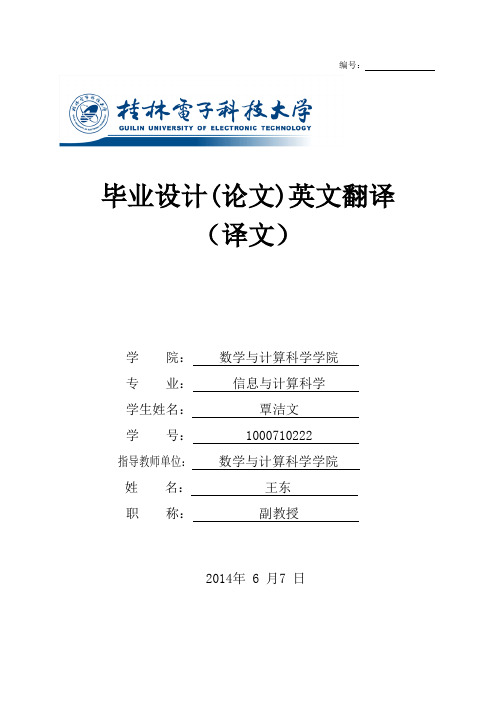
编号:毕业设计(论文)英文翻译(译文)学院:数学与计算科学学院专业:信息与计算科学学生姓名:覃洁文学号: 1000710222指导教师单位:数学与计算科学学院姓名:王东职称:副教授2014年 6 月7 日Parallel image encryption algorithm based on discretized chaotic mapAbstractRecently, a variety of chaos-based algorithms were proposed for image encryption. Nevertheless, none of them works efficiently in parallel computing environment. In this paper, we propose a framework for parallel image encryption. Based on this framework, a new algorithm is designed using the discretized Kolmogorov flow map. It fulfills all the requirements for a parallel image encryption algorithm. Moreover, it is secure and fast. These properties make it a good choice for image encryption on parallel computing platforms.1. IntroductionIn recent years, there is a rapid growth in the transmission of digital images through computer networks especiallythe Internet. In most cases, the transmission channels are not secure enough to prevent illegal access by malicious listeners. Therefore the security and privacy of digital images have become a major concern. Many image encryption methods have been proposed, of which the chaos-based approach is a promising direction [1–9].In general, chaotic systems possess several properties which make them essential components in constructingcryptosystems:(1) Randomness: chaotic systems generate long-period, random-like chaotic sequence ina deterministic way.(2) Sensitivity: a tiny difference of the initial value or system parameters leads to a vast change of the chaoticsequences.(3) Simplicity: simple equations can generate complex chaotic sequences.(4) Ergodicity: a chaotic state variable goes through all states in its phase space, and usually those states are distributeduniformly.In addition to the above properties, some two-dimensional (2D) chaotic maps are inherent excellent alternatives forpermutation of image pixels. Pichler and Scharinger proposed a way to permute the image using Kolmogorov flow mapbefore a diffusion operation [1,2]. Later, Fridrich extended this method to a more generalized way [3]. Chen et al. proposedan image encryption scheme based on 3D cat maps [4]. Lian et al. proposed another algorithm based on standardmap [5]. Actually, those algorithms work under the same framework: all the pixels are first permuted with a discretizedchaotic map before they are encrypted one by one under the cipher block chain (CBC) mode where the cipher of the current pixel is influenced by the cipher of previous pixels. The above processes repeat for several rounds and finally thecipher-image is obtained.This framework is very effective in achieving diffusion throughout the whole image. However, it is not suitable forrunning in a parallel computing environment. This is because the processing of the current pixel cannot start until theprevious one has been encrypted. The computation is still in a sequential mode even if there is more than one processingelement (PE). This limitation restricts its application platform since many devices based on FPGA/CPLD or digital circuitscan support parallel processing. With the parallel computing technique, the speed of encryption is greatly accelerated.Another shortcoming of chaos-based image encryption schemes is the relatively slowcomputing speed. The primaryreason is that chaos-based ciphers usually need a large amount of real number multiplication and division operations,which cost vast of computation. The computational efficiency will be increase substantially if the encryption algorithmscan be executed on a parallel processing platform.In this paper, we propose a framework for parallel image encryption. Under such framework, we design a secure andfast algorithm that fulfills all the requirements for parallel image encryption. The rest of the paper is arranged as follows. Section 2 introduces the parallel operating mode and its requirements. Section 3 presents the definitions and propertiesof four transformations which form the encryption/decryption algorithm. In Section 4, the processes ofencryption, decryption and key scheduling will be described in detail. Experimental results and theoretical analysesare provided in Sections 5 and 6, respectively. Finally, we conclude this paper with a summary.2. Parallel mode2.1 Parallel mode and its requirementsIn parallel computing mode, each PE is responsible for a subset of the image data and possesses its own memory.During the encryption, there may be some communication between PEs (see Fig. 1).To allow parallel image encryption, the conventional CBC-like mode must be eliminated. However, this will cause anew problem, i.e. how to fulfill the diffusion requirement without such mode. Besides, there arise some additional requirements for parallel image encryption:1. Computation load balance The total time of a parallel image encryption scheme is determined by the slowest PE, since other PEs have to waituntil such PE finishes its work. Therefore a good parallel computation mode can balance the task distributed to each PE.2. Communication load balance There usually exists lots of communication between PEs. For the same reason as of computation load, the communication load should be carefully balanced.3. Critical area management When computing in a parallel mode, many PEs may read or write the same area of memory (i.e. critical area) simultaneously,which often causes unexpected execution of the program. It is thus necessary to use some parallel techniquesto manage the critical area.2.2 A parallel image encryption frameworkTo fulfill the above requirements, we propose a parallel image encryption framework, which is a four-step process: Step 1: The whole image is divided into a number of blocks. Step 2: Each PE is responsible for a certain number of blocks. The pixels inside a block are encrypted adequately witheffective confusion and diffusion operations. Step 3: Cipher-data are exchanged via communication between PEs to enlarge the diffusion from a block to a broaderscope. Step 4: Go to step 2 until the cipher image reaches the required level of security.In step 2, diffusion is achieved, but only within the small scope of one block. With theaid of step 3, however, suchdiffusion effect is broadened. Note that from the cryptographic point of view, data exchange in step 3 is essentially apermutation. After several iterations of steps 2 and 3, the diffusion effect is spread to the whole image. This means thata tiny change in one plain-image pixel will spread to a substantial amount of pixels in the cipher-image. To make theframework sufficiently secure, two requirements must be fulfilled:1. The encryption algorithm in step 2 should be sufficiently secure with the characteristic of confusion and diffusion aswell as sensitivity to both plaintext and key.2. The permutation in step 3 must spread the local change to the whole image in a few rounds of operations.The first requirement can be fulfilled by a combination of different cryptographic elements such as S-box, Feistel-structure,matrix multiplications and chaos map, etc., or we can just use a conventional cryptographic standard suchas AES or IDEA. The second one, however, is a new topic resulted from this framework. Furthermore, such permutationshould help to achieve the three additional goals presented in Section 2.1. Hence, the permutation operation isone of the focuses of this paper and should be carefully studied.Under this parallel image encryption framework, we propose a new algorithm which is based on four basic transformations. Therefore, we will first introduce those transformations before describing our algorithm.3. Transformations3.1 A-transformationIn A-tran sformation, …A‟ stands for addition. It can be formally defined as follow: a+b=c ,where a,b,cϵG,G=GF(28), and the addition is defined as the bitwise XOR operation. The transformation A has three fundamental properties:(2.1)a+a=0(2.2)a+b=b+a (2)(2.3)(a+b)+c=a+(b+c)3.2 M-transformationIn M-transformation, …M‟ stands for mixing of data. First, we introduce the sum transformation: sum:m×n→Gthensum(I) is defined as: sum(1)= a(ij)Now we give the definition of M-transformation as follows: M:m×n→m×nLet M(I)=C I= a(ij)C=(c(ij)(3) c(ij)=a(ij)+sum(I)It is easy to prove the following properties of the M-transformation:(5.1)M(M(I))=I(5)(4) (5.2)M(I+J)=M(I)+M(J)(5.3)M(kj)=kM(I),where kI=1,k∈NIt should be noted that all the addition operations from are the A-transformation indeed.3.3 S-transformationIn S-transformation, …S‟ stands for S-box substitution. There are lots of ways to constructan S-box, among whichthe chaotic approach is a good candidate. For example, Tang et al presented a method to design S-box based on discretized logistic map and Baker map [10]. Following this work, Chen et al. proposed another method to obtain an S-box,which leads to a better performance [11]. The process is described as follows:Step 1: Select an initial value for the Chebyshev map. Then iterate the map to generate the initial S-box table.Step2: Pile up the 2D table to a 3D one.Step 3: Use the discretized 3D Baker map to shuffle the table for many times. Finally, transform the 3D table back to2D to obtain the desired S-box. Experimental results show that the resultant S-box is ideal for cryptographic applications. The approach is alsocalled …dynamic‟ as different S-boxes are obtained when the initial value of Chebyshev map is changed. However,for the sake of simplicity and performance, we use a fixed S-box, i.e. the example given in [11] (see Table 1).3.4 K-transformationIn K-transformation, …K‟ stands for Kolmogorov flow, which is often called generalized Baker map [3]. The applicationof Kolmogorov flow for image encryption was first proposed by Pichler and Scharinger [1,2]. The discrete version of K-flow is given by :whered = (n1,n2, . . . ,nk), ns is an positive integer, and ns divide N for all s, = 1/ns, while Fsis still the leftbound of the vertical strip s:Note that the Eq. (6) can be interpreted by the geometrical transformation shown in Fig.2. The N ·N image is firstdivided into vertical rectangles of height N and width ns. Then each vertical rectangle is further divided into boxes ofheight psand width ns. After K-transformation, pixels from the same box are actually mapped to a single row.Table 1The proposed S-box is the example given in [11]161 85 129 224 176 50 207 177 48 205 68 60 1 160 117 46130 124 203 58 145 14 115 189 235 142 4 43 13 51 52 19152 153 83 96 86 133 228 136 175 23 109 252 236 49 167 92106 94 81 139 151 134 245 72 172 171 62 79 77 231 82 32238 22 63 99 80 217 164 178 0 154 240 188 150 157 215 232180 119 166 18 141 20 17 97 254 181 184 47 146 233 113 12054 21 183 118 15 114 36 253 197 2 9 165 132 204 226 64107 88 55 8 221 65 185 234 162 210 250 179 61 202 248 247213 89 101 108 102 45 56 5 212 10 12 243 216 242 84 111143 67 93 123 11 137 249 170 27 223 186 95 169 116 163 25174 135 91 104 196 208 148 24 251 39 40 31 16 219 214 74140 211 112 75 190 73 187 244 182 122 193 131 194 149 121 76156 168 222 34 241 70 255 229 246 90 53 225 100 30 37 237103 126 38 200 44 209 42 29 41 218 71 155 78 125 173 28128 87 239 3 191 158 199 138 227 59 69 220 195 66 192 2304 MASK–aparallel image encryption scheme4.1.Outline of the proposed encryption schemeAssume the N·Nimage is encrypted by nPEssimultaneously, we describe the parallel encryption schemeas follows:1.Each PE is responsible for some fixe drow so fpixelsin the image.2. PixelsofeachrowareencryptedusingtransformationM,A,S,respectively.3. Permuteall the pixelsaccording to transformation Ktohavefur the rdiffusion.4. Goto step 2 forano the rroun do fencryptio nuntilthecip her issufficiently secure.Thereforeboththepermutationmapanditsparametersmustbecarefullychosen.Inouralgorithm ,disaconstantvectorwithlengthq,whereq=N/n.Eachelementofthevectorisequalton Each PE is responsible for q consecutive rows, or more specifically, the ith PE is responsible for rows from (i-1) * qto i* q-1. This algorithm can fulfil all the requirements for parallel encryption, as analyzed below.1.Diffusion effect in the whole imageAssume that the operations in step 2 are sufficiently secure. After step 2, a tiny change of the plain pixel will diffuse tothe whole row of N pixels. If we choose d according to Eq. (7), it is easy to prove that those N cipher pixels will bepermuted to different q rows with the help of K-transformation in step 3. In the same way, after another round ofencryption, the change is spread to q rows, and after the third round, the whole cipher image is changed. Consequently,in our scheme, the smallest change of any single pixel will diffuse to the whole image in 3 rounds.2.Balance of communication loadIf the parameter d of (6) is chosen as (7), it is easy to prove that the data exchanged between two PEs are constant,i.e., equal to 1/q2 of the total number of image pixels. For each PE, this quantity becomes (q _ 1)/q2. Therefore, inour scheme, the communication load of each PE is equivalent, and there is no unbalance of communication load forthe PEs at all.3. Balance of computation loadThe data to be encrypted by each PE is equally q rows of pixels; hence computation load balance is achievednaturally.4. Critical area managementIn our scheme, under no circumstances would two PEs read from or write to the same memory. Therefore, we do notneed to impose any critical area management technique in our scheme as other parallel computation schemes oftendo.The above discussions have shown that the proposed scheme fullfil all the requirements for parallel image encryption ,which is mainly attributed to the chaotic Kolmogorov map and the choice of its parameters.4.2 CipherThe cipher is made up of a number of rounds. However, before the first round, the image is pre-processed with a K-transformation.Then in each round, the transformation M, A, S, K is carried out, respectively. The final round differsslightly from the previous rounds in that the S-transformation is omitted on purpose. The transformations M, A, Soperate on one row of pixels by each PE, while the transformation K operates on the whole image which necessarilyinvolves communicationbetween PEs. The cipher is described by the pseudo-code listed in Fig. 3.4.3 Round key generationAmong the four transformations, only transformation A needs a round key. For an 8-bit grey level image of N ·Npixels, a round key containing N bytes should be generated for transformation A in each round.Generally speaking, the round keys should be pseudo-random and key-sensitive. From this point of view, a chaotic map is a good alternative. In our scheme, we use the skew tent map to generate the required round keys.x/μ,0<x<μx(1)=(1−x)/(1−u) ,μ<x<1 (8) The chaotic sequence is determined by the system parameter l and initial state x0 of the chaotic map either of whichis a real number between 0 and 1. Although the chaotic map equation is simple, it generates pseudo-random sequencesthat are sensitive to both the system parameter and the initial state. This property makes the map an ideal choice for keygeneration.When implemented in a digital computer, the state of the map is stored as a floating point number. The first 8 bits ofeach state are extracted as one byte of the round key. Accordingly, we need to iterate the skew tent map for N times ineach round.4.4 DecipherIn general, the decryption procedures are composed of a reversed order of the transformations performed in encryption. This property also holds in our scheme. However, with careful design, the decryption process of our scheme canhave the same, rather than the reversed, order of transformations as the cipher. This impressive characteristic attributesto two properties of the transformations:(1)Transformation-S and transformation-K are commutable. Transformation-S substitutes only the value of eachpixel and is independent of its position. On the other hand, transformation-K changes only a pixel‟s position with It‟s value unchanged. Consequently, the relation between the twotransformations can be expressed in (9):K(S(I))=S(K(I))(2) Transformation-Mis a linear operation according to (5). Moreover, the addition defined in (5.2) is actually transformationA. Thus the relation between the two transformations can be expressed in (10):M(A(I,J))=A(M(I),M(J)In short, either transformations S and K, or transformations M and Acan interchange their computation order withno influence on the final result. Table 2 illustrates how these two properties affect the order of the transformations ofdecipher in a simple example of 2-round cipher.It is easy to observe that for a cipher composed of multiple rounds, the decipher process still has the same sequenceof transformations as the cipher. Hence, both the cipher and decipher share the same framework. However, there are still some slight differences between the encryption and decryption processes:(1)The round keys used in decipher is in a reversed order of that in cipher, and those keysshould be first applied thetransformation M.(2)The transformation K and S in decipher should use their inversetransformations.However, since transformation K and S can both be implemented by look-up table operations, their inverse transformationsdiffer just in content of look-up tables. Consequently, all above difference in computations can be translatedinto difference in data.The symmetric property makes our scheme very concise. It also reduces lots of codes for a computer system implementingboth the cipher and decipher. For hardware implementation, this property results in a reduction of cost forboth devices.Table 2 The process of equivalent decipher in 2-round encryptionThe remarkable structure of our scheme looks more concise and saves a lot of codes during implementation. This isdefinitely an advantage when compared with other chaos-based ciphers5 Experimental resultsIn this section, an example is given to illustrate the effectiveness of the proposed algorithm. In the experiment, a greylevel image …Lena‟ of size 256 * 256 pixels, as shown in Fig. 4a, is chosen as the plain-image. The number of PEs is chosenas 4. The key of our system, i.e. the initial state x0 and the system parameter l are stored as floating point numberwith a precision of 56-bits. In the example presented here, x0 = 0.12345678, and l = 1.9999.When the encryption process is completed, the cipher-image is obtained and is shown in Fig. 4b. Typically, weencrypt the plain-image for 9 rounds as recommended.5.1 HistogramHistogram of the plain-image and the cipher-image is depicted in Figs. 4c and d, respectively. These two figures showthat the cipher-image possesses the characteristic of uniform distribution in contrast to that of the plain-image.5.2 Correlation analysis of two adjacent pixelsThe correlation analysis is performed by randomly select 1000 pairs of two adjacent pixels in vertical, horizontal,and diagonal direction, respectively, from the plain-image and the ciphered image. Then the correlation coefficientof the pixel pair is calculated and the result is listed in Table 3. Fig. 5 shows the correlation of two horizontally adjacentpixels. It is evident that neighboring pixels of the cipher-image has little correlation.5.3 NPCR analysisNPCR means the change rate of the number of pixels of the cipher-image when only one pixel of the plain-image ismodified. In our example, the pixel selected is the last pixel of the plain-image. Its value is changed from (01101111)2 to (01101110)2. Then the NPCR at different rounds are calculated and listed in Table 4. The data show that the performanceis satisfactory after 3 rounds of encryption. The different pixels of the two cipher-images after 9 rounds are plottedin Fig. 6. Fig. 4.(a) Plain-image, (b) cipher-image, (c) histogram of plain-image, (d) histogram of cipher-image. Table 3 Correlation coefficient of two adjacent pixels in plain-image and cipher-image. Fig.5. Correlation of two horizontally adjacent pixels of (a) plain image; (b) cipher image, x-coordinate and y-coordinate is the greylevel of twoneighbor pixels, respectively. Table 4 NPCR of two cipher-images at different rounds.5.4 UACI analysisThe unified average changing intensity (UACI) index measures the average intensity of differences between twoimages. Again, we make the same change as in Section 5.3 and calculate the UACI between two cipher-images. Theresults are in Table 5. After three rounds of encryption, the UACI is converged to 1/3. It should be noticed thatthe average error between two random sequences uniformly distribution in [0, 1] is 1/3 if they are completely uncorrelatedwith each other. Fig. 6.Difference between two ciphered images after 9 rounds. White points (about 1/256 of the total pixels) indicate the positionswhere pixels of the two cipher-images have the same values. Table 5 UACI of two cipher-images.6 Security and performance analysis6.1 DiffusionThe NPCR analysis has revealed that when there is only 1 bit of the plain pixel changed, almost all the cipher pixelsbecome different although there is still a low possibility of 1/256 that two cipher pixels are equal. This diffusion firstattributes to transformation S since change of any bit of the input to the S-box influences all the output bits at a changerate of 50%. Then, the diffusion is spread out to the whole row by transformation M. Finally, transformation K helps toenlarge the diffusion to 25% of the image in 2 rounds, and to the whole image in 3 rounds.6.2 ConfusionThe histogram and correlation analyses of adjacent pixels both indicate that our scheme possesses a good propertyof confusion. This mainly results from the pseudo-randomness of the key schedule and transformations M and A. Theywork together to introduce the random-like effect to the cipher image. Transformation K is also helpful in destroyingthe local similarity of the plain-image.6.3 Brute-force attackThe proposed scheme uses both the initial state x0 and the system parameter l as the secret key whose total number of bits is 112. It is by far very safe for ordinary business applications. Therefore, our scheme is strong enough to resistbrute-force attack. Moreover, it is very easy to increase the number of bits for both x0 and μ.6.4 Other security issuesSomeone may argue that, in our scheme, transformation K is not governed by any key. However, this reduces littlesecurity of our scheme. As a matter of fact, most conventional encryption algorithms such as DES and AES use publicpermutations. There are at least two reasons for it. First, permutations governed by key slow down the speed of encryption,for it costs time to generate those permutations from the key. Secondly and the foremost, weak permutations maybe generated from some keys, which harm to the security of the system. Actually, a permutation that helps to achievediffusion and confusion is a better alternative.More specifically, in a parallel encryption system, if the permutationhelps to achieve computation and communication load balance, it is a good alternative. From this point of view, transformationK is a proper choice.6.5 Performance analysisThe proposed algorithm runs very fast as there are only logical XOR and table lookup operations in the encryptionand decryption processes. Although multiplications and divisions are required in transformation K, the transformationis fixed once the number of PE is fixed. Hence, they can be pre-computed and stored in a lookup table. More accurately,there are only 3 XOR operations (2 for transformation M and 1 for transformation A) and 2 lookup table operations (1 for transformation S and 1 for transformation K) for each pixel in each round. On the contrary, for the simplest logisticmap with 56-bit precision state variable, one multiplication costs about 28 additions in average. In our keyschedule,multiplications are also required in the skew tent map. However, there are only N such multiplications in each round ,and hence an average of 1/N multiplications for each pixel per round. Furthermore, when the algorithm runs on a parallel platform, the performance can increase nearly n times than ordinary sequential image encryption scheme. Therefore, as far as the performance is concerned, our scheme is superior than existing ones.7 ConclusionIn this paper, we introduced the concept of parallel image encryption and presented several requirements for it. Thena framework for parallel image encryption was proposed and a new algorithm was designed based on this framework. The proposed algorithm is successful in accomplishing all the requirements for a parallel image encryption algorithmwith the help of discretized Kolmogorov flow map. Moreover, both the experimental results and theoretical analysesshow that the algorithm possesses high security. The proposed algorithm is also fast; there are only a couple ofXOR operations and table lookup operations for each pixel. Finally, the decryption process is identical to that ofthe cipher. Taking into account all the virtues mentioned above, the proposed algorithm is a good choice for encryptingimages in a parallel computing platform.References[1] Pichler F, Scharinger J. Ciphering by Bernoulli shifts in finite Abelian groups. Contributions togeneralalgebra. Proc. Linzconference1994. p. 465–76.[2] Scharinger J. Fast encryption of image data using chaotic Kolmogorov flows. J Electron Image1998;7(2):318–25.[3] Fridrich J. Symmetric ciphers based on two-dimensional chaotic maps. I J Bifur Chaos1998;8(6):1259–64.[4] Chen G, Mao Y, Chui C. Symmetric image encryption scheme based on 3D chaotic cat maps. Chaos,Solitons& Fractals2004;21(3):749–61.[5] Lian S, Shun J, Wang Z. A block cipher based on a suitable use of the chaotic standard map. Chaos,Solitons& Fractals2005;26(1):117–29.[6] Guan Z, Huang F, Guan W. Chaos-based image encryption algorithm. PhysLett A 2005;346(1–3):153–7.[7] Zhang L, Liao X, Wang X. An image encryption approach based on chaotic maps. Chaos, Solitons&Fractals 2005;24(3):759–65.[8] Gao H, Zhang Y, Liang S, Li D. A new chaotic algorithm for image encryption. Chaos, Solitons&Fractals 2006;29(2):393–9.[9] Pareek NK, Patidar V, Sud KK. Image encryption using chaotic logistic map. Image Vision Comput2006;24(9):926–34.[10] Tang Guoping, Liao Xiaofeng, Chen Yong. A novel method for designing S-boxes based on chaoticmaps. Chaos, Solitons&Fractals 2005;23:413–9.[11] Chen G, Chen Y, Liao X. An extended method for obtaining S-boxes based on three-dimensionalchaotic Baker maps. Chaos,Solitons& Fractals 2007;31(3):571–9Digital Image Processing1 IntroductionMany operators have been proposed for presenting a connected component n a digital image by a reduced amount of data or simplied shape. In general we have to state that the development, choice and modi_cation of such algorithms in practical applications are domain and task dependent, and there is no \best method". However, it is interesting to note that there are several equivalences between published methods and notions, and characterizing such equivalences or di_erences should be useful to categorize the broad diversity of published methods for skeletonization. Discussing equivalences is a main intention of this report.1.1 Categories of MethodsOne class of shape reduction operators is based on distance transforms. A distance skeleton is a subset of points of a given component such that every point of this subset represents the center of a maximal disc (labeled with the radius of this disc) contained in the given component. As an example in this _rst class of operators, this report discusses one method for calculating a distance skeleton using the d4 distance function which is appropriate to digitized pictures. A second class of operators produces median or center lines of the digital object in a non-iterative way. Normally such operators locate critical points _rst, and calculate a speci_ed path through the object by connecting these points.The third class of operators is characterized by iterative thinning. Historically, Listing [10] used already in 1862 the term linear skeleton for the result of a continuous deformation of the frontier of a connected subset of a Euclidean space without changing the connectivity of the original set, until only a set of lines and points remains. Many algorithms in image analysis are based on this general concept of thinning. The goal is a calculation of characteristic properties of digital objects which are not related to size or quantity. Methods should be independent from the position of a set in the plane or space, grid resolution (for digitizing this set) or the shape complexity of the given set. In the literature the term \thinning" is not used .in a unique interpretation besides that it always denotes a connectivity preserving reduction operation applied to digital images, involving iterations of transformations of speci_ed contour points into background points. A subset Q _ I of object points is reduced by a de_ned set D in one iteration, and the result Q0 = Q n D becomes Q for the next iteration.。
基于改进的Logistic混沌映射彩色图像加密算法

基于改进的Logistic混沌映射彩色图像加密算法黄硕【摘要】针对彩色图像加密算法需满足加密速度快、Kerckhoff原则、密钥空间大、解密保真度高这4个基本要求,提出了一种改进的具有较大密钥空间的Logistic混沌映射来产生混沌密码序列并在序列异或加密算法上进行改进,通过实验仿真,从直方图、加密效果评价参数、抗剪裁、抗噪声、相关性、密钥空间大小等方面进行了加密效果分析,结果表明该算法可以实现快速地对图像数据流进行实时加解密。
%In order to satisfy the color image encryption algorithms′four basic requirements which are the encryption speed,Kerck-hoff principle,large key space,and high fidelity of decryption,this paper proposes an improved and large-key-space-having Logistic chaotic map,which can generate the chaotic password sequences. Meanwhile,this paper presents an improved sequence and XOR en-cryption algorithm,fulfills the experimental simulations,and analyzes the encryption effects through the histogram,the encryption effect evaluation parameters,the performances of cutting-resistant and noise-resistant,correlation,and the size of the key space,re-spectively. The experiment results show that the proposed algorithm can realize the real-time encryption and decryption of color image stream quickly.【期刊名称】《河南工程学院学报(自然科学版)》【年(卷),期】2015(000)002【总页数】5页(P63-67)【关键词】彩色图像;加密算法;Logistic混沌映射;异或;加密效果【作者】黄硕【作者单位】信阳职业技术学院数学与计算机学院,河南信阳464000【正文语种】中文【中图分类】TP339图像加密是保护图像安全的一种直接有效的手段,众多学者对图像加密技术做了大量研究并取得了丰富的成果,如基于现代密码体制的图像加密、基于矩阵变换的图像加密、基于混沌的图像加密、基于分存的图像加密、基于频域的图像加密、基于SCAN语言的图像加密和基于DNA计算的图像加密等[1].针对彩色图像加密设计,需要考虑以下四点基本要求:加解密速度快、Kerckhoff原则、密钥空间大、解密保真度高.根据这四点基本要求,在不需要压缩加密的前提下,应该尽量选择在RGB色彩模型空间或空域上进行,并综合考虑运行速度、抗攻击能力、密钥空间大小、抗噪声及抗剪裁能力等因素来设计加解密算法.因此,针对密钥情况提出了一种改进的、具有较大密钥空间的Logistic混沌映射来产生混沌密码序列;针对加密算法在序列异或加密算法上进行改进,以避免单纯异或加密的缺点,同时又保留了加解密速度快的优点;针对加密效果,通过实验仿真,并从直方图、加密效果评价参数、抗剪裁、抗噪声、相关性、密钥空间大小等方面进行了深入分析.Logistic映射方程来自现实中的人口统计,是典型的非线性用来描述混沌状态的方程,能够简单地表现混沌运动的一般特征.传统单一性的Logistic算法过程如下:① 挑选恰当的Logistic方程生成密钥序列的算法;② 输入作为加解密初始密钥的初值;③ 从目前所处的轨迹启动迭代程序;④ 形成混沌运动的实数序列,将这些序列转化为方便处理的二进制序列;⑤ 将其中某部分的明/密文选为带加/解密明文;⑥ 用异或运算来处理所得到的二进制序列与当前的待加密明文/待解密密文,结果为密/明文序列;⑦ 将目前运算的行踪作为下一次加/解密的初始密钥;⑧ 对加/解密是否完成进行判断,没有完成则返回到第③步;⑨ 加/解密完成.传统的Logistic加密算法方便快捷、便于实现,并且由于混沌系统本身对初值比较敏感,又有随机性,这使得传统的Logistic算法具有一定的安全性.但是,传统的Logistic算法缺点也非常明显,主要有以下几点:(1) 通过试验总结出来的混沌序列的周期、伪随机性和复杂性,很难保证这些参数都足够高;(2) 为了保证一样的周期,混沌函数内部所使用的存储器数目是寄存器的两倍;(3) 混沌序列发生器使用的是有限精度器,有限的精度是实际应用混沌序列的一大障碍.其中,缺陷(3)非常突出,故基于此对传统的Logistic系统进行了改进.Logistic映射是用得最广的一种混沌系统,其定义如下:其中,0<μ≤4称为分支参数,xk∈(0,1),当3.569 946<μ≤4时,Logistic映射处于混沌状态,也就是说初始条件x0在Logistic映射的作用下所产生的序列{xk}是非周期性的、不收敛的并对初始值非常敏感.因此,若仅仅用以上一维Logistic混沌映射来产生混沌密码序列已不够安全,极易暴露混沌系统的相关信息.为了提高系统的混沌程度,张靓[2]提出了一种改进的二维Logistic混沌映射,如下式所示:当3.81≤u≤3.815时,其最大Lyapunov指数在2.2左右,该映射处于混沌状态.但是,根据Kerckhoff原则,要求密钥空间尽可能大,为了增大式(2)Logistic 混沌映射的混沌度,结合Chebychev混沌映射,如下式所示:对式(2)所示的Logistic混沌映射的参数μ进行扰动,即μ不再是一个定值,而是随Chebychev混沌映射的值而动态地变化.当参数k=6时,Chebychev系统的Lyapunov指数为1.791 733…,映射处于混沌状态且zn∈[-1 1].由此,可构造新的参数μ的表达式,如下式所示:从而,式(2)变成了式(5),即为本算法所提出的改进的Logistic混沌映射:通过Matlab编程,当x0=0.345 678,y0=0.578 993,z0=0.234 567时,式(5)在迭代1 000次后的三维散点图如图1所示.在迭代100万次后,统计得到xn,yn,zn的值域(只显示16位有效数字)分别如下:同时,通过Matlab中的tabulate函数对xn,yn,zn进行了频数统计,发现每一个值都只出现了1次,表明所提出的Logistic混沌映射系统能产生较高随机性的3组混沌序列.针对一幅M×N的24位真彩色图像,共有M×N个像素和M×N×3个灰度值.鉴于图像异或加密的简单性与快速性,将其进行改进,提出一种新的加解密算法,整体流程如图2所示.加密步骤如下:(1)输入密钥x0,y0,z0和I,其中x0,y0,z0分别为式(5)所示混沌映射的初始值,I为混沌序列的初始迭代次数.然后,产生两组长度为M×N×3的一维混沌密码序列SX和SY,其产生方式如下式所示:其中,i∈[1M×N×3],xi和yi分别为式(5)在迭代I+i次后的值.(2)对原图像的数据序列进行先异或运算再求和求余运算,其加密公式如下式所示: 其中,Pi表示彩色图像每个像素的R或G或B分量的值,为加密后的值.解密算法是加密的逆过程,具体步骤如下:(1)与加密过程一样,由式(5)和式(6)产生两组长度为M×N×3的一维混沌密码序列SX,SY;(2)对加密图像的数据序列进行先求和求余运算再异或运算,其解密公式如下式所示,最后得到解密图像:式(8)也可以写成式(9)的形式:以大小为256×256个灰度级、24位真彩色的Lina图像(如图3(a)所示)为实验对象,设定初始密钥值为x0=0.345 678,y0=0.578 993,z0=0.234 567,I=222,加密效果如图3(b)所示,正常解密图像如图3(c)所示,当改变密钥x0=0.345 678 1时的解密图像如图3(d)所示.可以看出,加密图像在直观上已经变得杂乱无章,即使微小改动初始密钥值,也不能获得原图像的任何信息,体现了该加密算法对密钥有较强的敏感性.原图像和加密图像的直方图分别如图4(a)和4(b)所示.可以看出,加密后的直方图变得非常均匀,图像的像素变化大,通过直方图信息来破解图像将会变得非常困难. 图像加密效果的评价是在原始图像与加密后的图像之间进行的.设原始图像为O,加密后的图像为E,则O(i)和E(i)分别代表各自数组中第i个元素代表的亮度值,数组的长度为n.(1)信息熵:其中,p(xi)表示符号集中符号xi在消息中出现的概率,l表示灰度等级数,也表示符号的个数,本系统中l为256个,即为0~255.显然,信息X的不确定性越大,信息熵越高.当所有变量出现的概率都相同时,信息熵最大,本系统中的最大信息熵为log2256=8.(2)灰度平均变化值:当两个图像的灰度产生均匀变化时,图像置乱的效果是最好的,并且越均匀安全性越高,最好的情况应该是图像灰度平均变化值为128.(3)图像相似度:若原图像与加密图像完全相同,则其相似度为1,即完全相似.对于加密图像来说,与原图像的相似度越小,安全性就越高.以蓝色分量为例,对加密前后图像的信息熵、灰度平均变化值和图像相似度进行了统计,如表1所示.可以看出,加密后图像的信息熵大大增加,加密前后的相似度也较小,表明加密效果较好.由于算法没有涉及像素间的置乱操作,故灰度变化值不是特别大.对加密后的图像(如图3(b)所示)进行1/8剪裁,如图5(a)所示,然后进行解密操作,得到解密后的图像,如图5(b)所示.可以看出,剪裁部分对未被剪裁部分图像的解密没有任何影响,表明该算法抗剪裁能力较强.对加密后的图像如图3(b)所示,每个像素的RGB分量都增加0~20的随机值,当值超过255时以255代替,然后进行解密操作,得到解密后的图像如图6所示.可以看出,解密后的图像基本能恢复原图像的信息,但存在部分失真,这表明该算法具有一定的抗随机噪声能力.(1)在改进的方法中,对μ进行扰动,使它不再是一个定值,这样增大了密钥空间并提高了Logistic的混沌度,使得混沌系统的相关信息不易被暴露,提高了安全度;(2)经过改进之后,对xn,yn,zn进行处理,在统计过程中每个值都出现了一次,这说明在迭代的过程中,没有出现同样的xn,yn,zn,这解决了单纯的Logistic映射的有限精度所导致的周期循环问题;(3)彩色图像加密算法设计应考虑以下四点基本要求:加解密速度快、Kerckhoff原则、密钥空间大、解密保真度高.对传统的算法和改进后的算法做一些随机性的比较,结果见表2.(1)为了抵抗解密图像的破解攻击,需在保证加密运算速度和低资源消耗的前提下,尽量增大系统的密钥空间.因此,结合Chebychev混沌映射的值域为[-1,1]的特性,设计算法对二维Logistic混沌系统的参数μ进行迭代变化,大大增加了密钥空间.该算法在序列异或加密算法上进行了改进,改进后的算法非常简单,可以对图像数据流快速地实时加解密.(2)彩色图像加密算法设计时应考虑以下四点基本要求:加解密速度快、Kerckhoff 原则、密钥空间大、解密保真度高.在不需要压缩加密的前提下,应该尽量选择在RGB色彩模型空间或空域上进行,并且要综合考虑运行速度、抗攻击能力、密钥空间大小、抗噪声及抗剪裁能力等因素.[1] 张晓强,王蒙蒙,朱贵良,等.图像加密算法研究新进展[J].计算机工程与科学,2012,34(5):1-6.[2] 张靓.混沌伪随机序列发生器设计及应用[D].哈尔滨:黑龙江大学,2008.Key words:color image; encryption algorithm; Logistic chaotic map; XOR; encryption effect。
毕业设计-英文翻译、译文--一种混沌图像加密并行算法-英译中附英文原文【范本模板】

附件C :译文基于离散混沌映射的图像加密并行算法摘要:最近,针对图像加密提出了多种基于混沌的算法。
然而,它们都无法在并行计算环境中有效工作。
在本文中,我们提出了一个并行图像加密的框架.基于此框架内,一个使用离散柯尔莫哥洛夫流映射的新算法被提出.它符合所有并行图像加密算法的要求.此外,它是安全、快速的。
这些特性使得它是一个很好的基于并行计算平台上的图像加密选择。
1. 介绍最近几年,通过计算机网络尤其是互联网传输的数字图像有了快速增长。
在大 多数情况下,传输通道不够安全以防止恶意用户的非法访问。
因此,数字图像的安全性和隐私性已成为一个重大问题.许多图像加密方法已经被提出,其中基于混沌的方法是一种很有前途的方向[1-9].总的来说,混沌系统具有使其成为密码系统建设中重要组成部分的几个属性:(1)随机性:混沌系统用确定的方法产生长周期、随机的混沌序列。
(2)敏感性:初始值或系统参数的微小差异导致混沌序列的巨大变化. (3)易用性:简单的公式可以产生复杂的混沌序列。
(4)遍历性:一个混沌状态的变量能够遍历它的相空间里的所有状态,通常这些状态都是均匀分布的.除了上述性能,有些二维(2D )的混沌映射是图像像素置换天生的优良替代者。
Pichler 和Scharinger 提出一种在扩散操作[1,2]之前使用柯尔莫哥洛夫流映射的图像排列方式.后来,Fridrich 将此方法扩展到更广义的方式[3].陈等人提出基于三维猫映射的图像加密算法[4]l 。
Lian 等人提出基于标准映射的另一种算法[5]。
其实,这些算法在相同的框架下工作:所有的像素在用密码分组链接模式(CBC)模式下的加密之前首先被用离散混沌映射置换,当前像素密文由以前的像素密文影响。
上述过程重复几轮,最后得到加密图像.这个框架可以非常有效的实现整个图像的扩散。
但是,它是不适合在并行计算环境中运行。
这是因为当前像素的处理无法启动直到前一个像素已加密.即使有多个处理元素(PE),这种计算仍然是在一个串行模式下工作.此限制了其应用平台,因为许多基于FPGA / CPLD或者数字电路的设备可以支持并行处理。
基于Logistic序列的数字图像加密技术研究
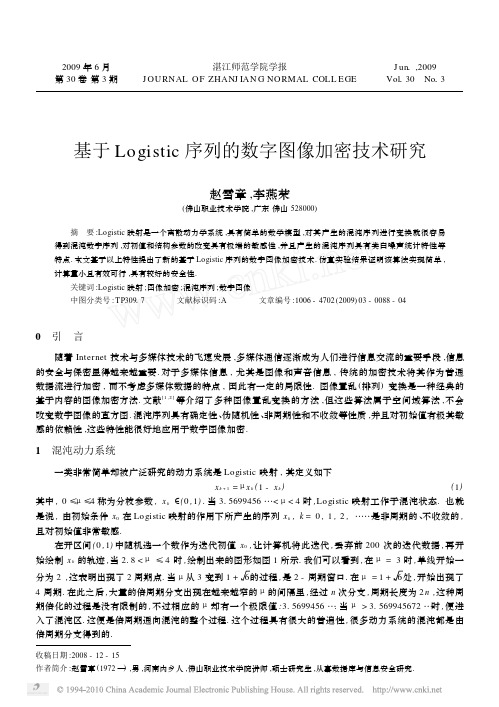
为下一轮叠代轨迹 ,然后生成二进制序列 ,同明文序列异或生成密文 ,从明文中取出下一部分明文 ,与迭代后
的序列值异或 ,直至加密完全部的明文 (如图 2) .
解密流程 :将 Logistic 映射初值和系统参数 (密钥) 代入方程求出系统的轨迹 ,保留系统的当前轨迹并作
为下一轮叠代轨迹 ,然后生成二进制序列 ,同密文序列异或生成明文 ,从密文中取出下一部分明文 ,与迭代后
Research on the Digital Image Encryption Technology Based on the Logistic Sequence
Z H A O X ue2z han g , L I Y an2ron g ( Fo shan Polytechnic , Fshan , Guangdo ng 528000 , China)
参考文献 :
[ 1 ] IEEE - SA Standards Board. IEEE 802. Q Standard [ S] . P. - SNMP + + 2. 6 Vser Guider http : ∥www. hp . com. 2008 12 - 101
[ 2 ] Hewlett - Packard Company. SNMP + + 2. 6 U ser Guider[ EB/ OL ] . http ∥www. hp . co m. 2008 - 12 - 21 [ 3 ] 文志强 ,李陶深 ,张增芳 1 一种新的基于混沌序列的图像加密技术[J ]1 计算机工程 ,2005 ,31 (10) :130 - 131. [ 4 ] 陈 果 1 一种基于混沌映射的图像加密算法[J ]1 计算机应用 ,2005 ,25 (12) :121 - 122. [ 5 ] 杨 晶 1 混沌序列加密算法应用研究[J ] . 自动化技术与应 ,2004 ,23 (02) :57 - 581
仓储物流外文文献翻译中英文原文及译文2023-2023

仓储物流外文文献翻译中英文原文及译文2023-2023原文1:The Current Trends in Warehouse Management and LogisticsWarehouse management is an essential component of any supply chain and plays a crucial role in the overall efficiency and effectiveness of logistics operations. With the rapid advancement of technology and changing customer demands, the field of warehouse management and logistics has seen several trends emerge in recent years.One significant trend is the increasing adoption of automation and robotics in warehouse operations. Automated systems such as conveyor belts, robotic pickers, and driverless vehicles have revolutionized the way warehouses function. These technologies not only improve accuracy and speed but also reduce labor costs and increase safety.Another trend is the implementation of real-time tracking and visibility systems. Through the use of RFID (radio-frequency identification) tags and GPS (global positioning system) technology, warehouse managers can monitor the movement of goods throughout the entire supply chain. This level of visibility enables better inventory management, reduces stockouts, and improves customer satisfaction.Additionally, there is a growing focus on sustainability in warehouse management and logistics. Many companies are implementing environmentally friendly practices such as energy-efficient lighting, recycling programs, and alternativetransportation methods. These initiatives not only contribute to reducing carbon emissions but also result in cost savings and improved brand image.Furthermore, artificial intelligence (AI) and machine learning have become integral parts of warehouse management. AI-powered systems can analyze large volumes of data to optimize inventory levels, forecast demand accurately, and improve operational efficiency. Machine learning algorithms can also identify patterns and anomalies, enabling proactive maintenance and minimizing downtime.In conclusion, warehouse management and logistics are continuously evolving fields, driven by technological advancements and changing market demands. The trends discussed in this article highlight the importance of adopting innovative solutions to enhance efficiency, visibility, sustainability, and overall performance in warehouse operations.译文1:仓储物流管理的当前趋势仓储物流管理是任何供应链的重要组成部分,并在物流运营的整体效率和效力中发挥着至关重要的作用。
一种基于Logistic映射和Bernoulli移位映射的图像加密算法
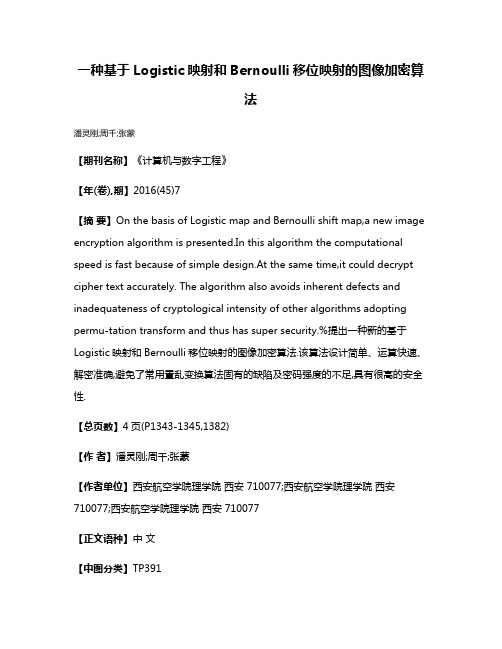
一种基于Logistic映射和Bernoulli移位映射的图像加密算法潘灵刚;周千;张蒙【期刊名称】《计算机与数字工程》【年(卷),期】2016(45)7【摘要】On the basis of Logistic map and Bernoulli shift map,a new image encryption algorithm is presented.In this algorithm the computational speed is fast because of simple design.At the same time,it could decrypt cipher text accurately. The algorithm also avoids inherent defects and inadequateness of cryptological intensity of other algorithms adopting permu-tation transform and thus has super security.%提出一种新的基于Logistic映射和Bernoulli移位映射的图像加密算法.该算法设计简单、运算快速、解密准确,避免了常用置乱变换算法固有的缺陷及密码强度的不足,具有很高的安全性.【总页数】4页(P1343-1345,1382)【作者】潘灵刚;周千;张蒙【作者单位】西安航空学院理学院西安 710077;西安航空学院理学院西安710077;西安航空学院理学院西安 710077【正文语种】中文【中图分类】TP391【相关文献】1.一种基于改进Logistic混沌映射的图像加密算法 [J], 韩凤英2.一种基于Logistic映射的混沌图像加密算法 [J], 严春来3.一种基于猫映射和伯努利移位映射的图像加密算法 [J], 郭伟创;叶瑞松4.一种基于延迟反馈Logistic映射的彩色图像加密算法 [J], 谭冬文;李彩虹;李守亮;李廉5.一种基于Logistic-Sine-Cosine映射的彩色图像加密算法 [J], 张赛男;李千目因版权原因,仅展示原文概要,查看原文内容请购买。
基于Logistic映射的多重图像加密技术
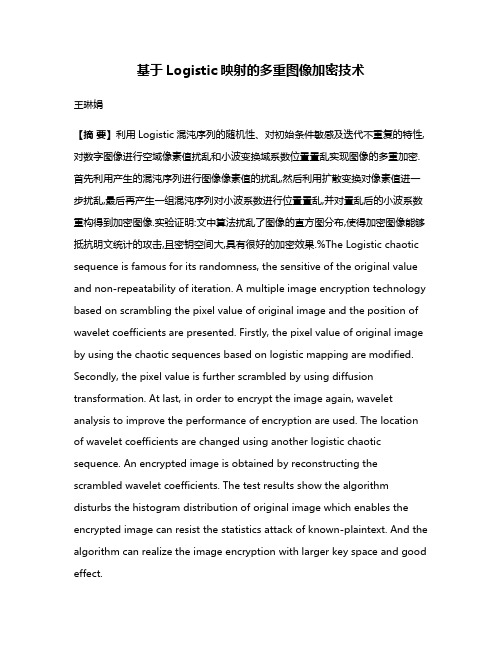
基于Logistic映射的多重图像加密技术王琳娟【摘要】利用Logistic混沌序列的随机性、对初始条件敏感及迭代不重复的特性,对数字图像进行空域像素值扰乱和小波变换域系数位置置乱实现图像的多重加密.首先利用产生的混沌序列进行图像像素值的扰乱,然后利用扩散变换对像素值进一步扰乱,最后再产生一组混沌序列对小波系数进行位置置乱,并对置乱后的小波系数重构得到加密图像.实验证明:文中算法扰乱了图像的直方图分布,使得加密图像能够抵抗明文统计的攻击,且密钥空间大,具有很好的加密效果.%The Logistic chaotic sequence is famous for its randomness, the sensitive of the original value and non-repeatability of iteration. A multiple image encryption technology based on scrambling the pixel value of original image and the position of wavelet coefficients are presented. Firstly, the pixel value of original image by using the chaotic sequences based on logistic mapping are modified. Secondly, the pixel value is further scrambled by using diffusion transformation. At last, in order to encrypt the image again, wavelet analysis to improve the performance of encryption are used. The location of wavelet coefficients are changed using another logistic chaotic sequence. An encrypted image is obtained by reconstructing the scrambled wavelet coefficients. The test results show the algorithm disturbs the histogram distribution of original image which enables the encrypted image can resist the statistics attack of known-plaintext. And the algorithm can realize the image encryption with larger key space and good effect.【期刊名称】《科学技术与工程》【年(卷),期】2011(011)008【总页数】5页(P1818-1821,1827)【关键词】图像加密;Logistic映射;混沌序列;小波变换【作者】王琳娟【作者单位】山西农业大学文理学院,太谷,030801【正文语种】中文【中图分类】TP309.7目前,图像信息的交流是人们在Internet上进行信息交流的主要手段,图像信息安全与加密技术已受到人们的广泛关注。
一种基于量子密钥与混沌映射的图像加密新方法
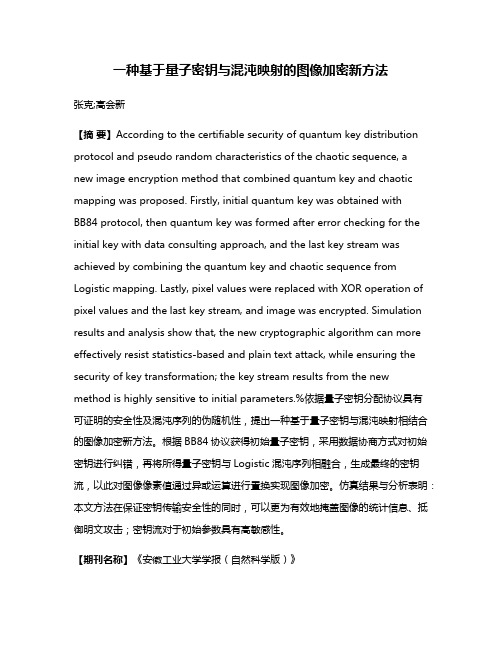
一种基于量子密钥与混沌映射的图像加密新方法张克;高会新【摘要】According to the certifiable security of quantum key distribution protocol and pseudo random characteristics of the chaotic sequence, a new image encryption method that combined quantum key and chaotic mapping was proposed. Firstly, initial quantum key was obtained withBB84 protocol, then quantum key was formed after error checking for the initial key with data consulting approach, and the last key stream was achieved by combining the quantum key and chaotic sequence from Logistic mapping. Lastly, pixel values were replaced with XOR operation of pixel values and the last key stream, and image was encrypted. Simulation results and analysis show that, the new cryptographic algorithm can more effectively resist statistics-based and plain text attack, while ensuring the security of key transformation; the key stream results from the new method is highly sensitive to initial parameters.%依据量子密钥分配协议具有可证明的安全性及混沌序列的伪随机性,提出一种基于量子密钥与混沌映射相结合的图像加密新方法。
基于改进Logistic映射的二值序列置乱加密算法
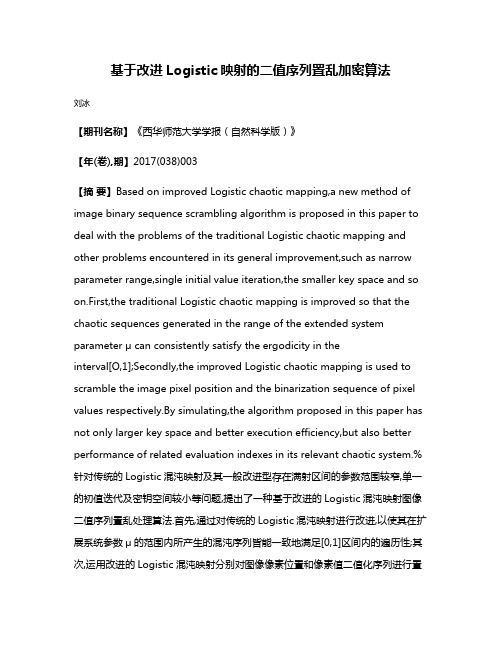
基于改进Logistic映射的二值序列置乱加密算法刘冰【期刊名称】《西华师范大学学报(自然科学版)》【年(卷),期】2017(038)003【摘要】Based on improved Logistic chaotic mapping,a new method of image binary sequence scrambling algorithm is proposed in this paper to deal with the problems of the traditional Logistic chaotic mapping and other problems encountered in its general improvement,such as narrow parameter range,single initial value iteration,the smaller key space and so on.First,the traditional Logistic chaotic mapping is improved so that the chaotic sequences generated in the range of the extended system parameter μ can consistently satisfy the ergodicity in theinterval[O,1];Secondly,the improved Logistic chaotic mapping is used to scramble the image pixel position and the binarization sequence of pixel values respectively.By simulating,the algorithm proposed in this paper has not only larger key space and better execution efficiency,but also better performance of related evaluation indexes in its relevant chaotic system.%针对传统的Logistic混沌映射及其一般改进型存在满射区间的参数范围较窄,单一的初值迭代及密钥空间较小等问题,提出了一种基于改进的Logistic混沌映射图像二值序列置乱处理算法.首先,通过对传统的Logistic混沌映射进行改进,以使其在扩展系统参数μ的范围内所产生的混沌序列皆能一致地满足[0,1]区间内的遍历性;其次,运用改进的Logistic混沌映射分别对图像像素位置和像素值二值化序列进行置乱处理.仿真实验表明,提出的算法不仅具有更大的密钥空间和更好的执行效率,而且其他对应的混沌系统相关评价指标的性能也较好.【总页数】7页(P340-346)【作者】刘冰【作者单位】达州职业技术学院,四川达州635001;西南大学计算机与信息科学学院,重庆400715【正文语种】中文【中图分类】TP309【相关文献】1.一种基于改进的logistic映射的混沌序列加密算法 [J], 张翌旸n;刘胜长;董妍2.一种基于改进的logistic映射的混沌序列加密算法 [J], 张翌旸;刘胜长;董妍3.一种基于二维Logistic混沌映射的VEA置乱加密算法设计 [J], 梁元;李建平;郭科4.基于改进Arnold映射二次置乱的图像加密算法 [J], 胡春杰;嵇海祥;牛智星;阮聪;陈翠5.基于二维Logistic混沌映射与DNA序列运算的图像加密算法 [J], 方鹏飞;黄陆光;娄苗苗;蒋昆因版权原因,仅展示原文概要,查看原文内容请购买。
基于改进广义cat映射的彩色卫星图像加密算法
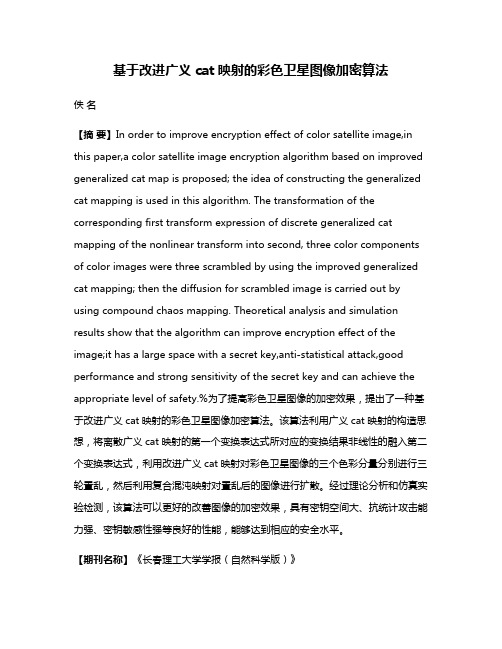
基于改进广义cat映射的彩色卫星图像加密算法佚名【摘要】In order to improve encryption effect of color satellite image,in this paper,a color satellite image encryption algorithm based on improved generalized cat map is proposed; the idea of constructing the generalized cat mapping is used in this algorithm. The transformation of the corresponding first transform expression of discrete generalized cat mapping of the nonlinear transform into second, three color components of color images were three scrambled by using the improved generalized cat mapping; then the diffusion for scrambled image is carried out by using compound chaos mapping. Theoretical analysis and simulation results show that the algorithm can improve encryption effect of the image;it has a large space with a secret key,anti-statistical attack,good performance and strong sensitivity of the secret key and can achieve the appropriate level of safety.%为了提高彩色卫星图像的加密效果,提出了一种基于改进广义cat映射的彩色卫星图像加密算法。
基于 Arnold 变换的图像加密研究
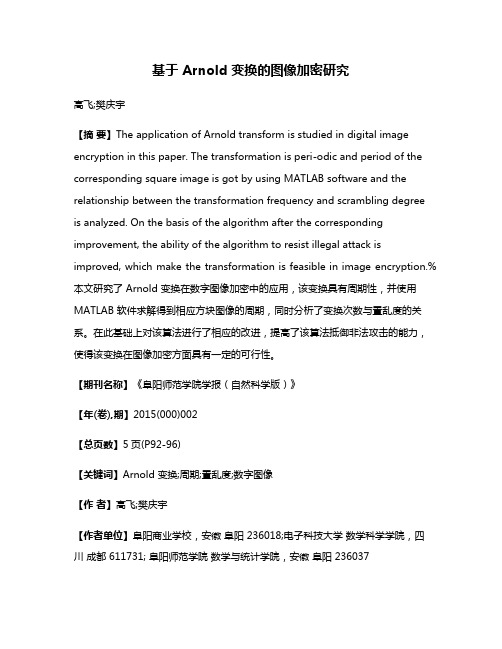
基于 Arnold 变换的图像加密研究高飞;樊庆宇【摘要】The application of Arnold transform is studied in digital image encryption in this paper. The transformation is peri-odic and period of the corresponding square image is got by using MATLAB software and the relationship between the transformation frequency and scrambling degree is analyzed. On the basis of the algorithm after the corresponding improvement, the ability of the algorithm to resist illegal attack is improved, which make the transformation is feasible in image encryption.%本文研究了 Arnold 变换在数字图像加密中的应用,该变换具有周期性,并使用MATLAB 软件求解得到相应方块图像的周期,同时分析了变换次数与置乱度的关系。
在此基础上对该算法进行了相应的改进,提高了该算法抵御非法攻击的能力,使得该变换在图像加密方面具有一定的可行性。
【期刊名称】《阜阳师范学院学报(自然科学版)》【年(卷),期】2015(000)002【总页数】5页(P92-96)【关键词】Arnold 变换;周期;置乱度;数字图像【作者】高飞;樊庆宇【作者单位】阜阳商业学校,安徽阜阳 236018;电子科技大学数学科学学院,四川成都 611731; 阜阳师范学院数学与统计学院,安徽阜阳 236037【正文语种】中文【中图分类】TP3911 背景信息安全有时被称为计算机安全,其主要任务是防止信息在未经授权的情况下被恶意地使用、披露、修改、阅读、检查、记录或破坏。
- 1、下载文档前请自行甄别文档内容的完整性,平台不提供额外的编辑、内容补充、找答案等附加服务。
- 2、"仅部分预览"的文档,不可在线预览部分如存在完整性等问题,可反馈申请退款(可完整预览的文档不适用该条件!)。
- 3、如文档侵犯您的权益,请联系客服反馈,我们会尽快为您处理(人工客服工作时间:9:00-18:30)。
杭州电子科技大学毕业设计(论文)外文文献翻译毕业设计(论文)题目保密监控系统设计翻译(1)题目一个基于修改后的Logistics映射的图片加密方案翻译(2)题目基于ARM嵌入式的混沌加密和AES加密算法的实现学院专业姓名班级学号指导教师一个基于修改后的Logistics 映射的图片加密方案1摘要-为了提高混沌加密算法的安全性,在本篇文章中提出了一个修改后的混沌映射。
相比于原始的混沌映射,修改后的映射总是能保持混沌状态并且使迭代范围从原来的(0,1)扩展到(0,4λ)(λ> 0.25)。
我们设计了一个基于加密方案,提出了映射实现图像加密。
一些仿真结果表明,修改后的Logistics 映射与原始Logistics 映射相比拥有更大的密钥空间,更快的生成速率和序列加密速度快。
1. 引言近年来,数字信息已广泛应用在许多领域。
我们有很多的私人多媒体来源和从任何这些来源应该受到保护未经授权的操作。
混沌具有非线性动态特性和对初始条件敏感。
由于混沌序列的性质,它广泛应用于密码学、控制和通信。
离散混沌系统的效率很高,但低安全,因为其密钥空间小,连续混沌系统具有更高的安全性,但低效率,因为它的计算很复杂。
本文提出了一种修改后的混度映射,它包含两个参数,可以把映射的范围从最初的0-1扩展到0-4()。
扩大混度序列的密钥空间和提高混沌序列生成的速度很重要。
一个基于混沌映射加密算法被设计出来,经过分析,显示出其良好的性能。
2. 混沌序列生成最近一维混沌映射因为其很简单且高效已被广泛使用在各种加密领域。
但是它也有很多缺点,比如密钥生成范围小,安全性低。
我们在本次设计中就经过修改混沌映射来克服这些缺点。
A.一个新修改后的Logistics 映射 其数学定义公式如下:1n x +=n x μ(1-n x ) μ∈[0,4] x ∈[0,1] ①其中μ∈[0,4]被称为Logistic 参数。
当u 在3.6到4之间,映射呈现混沌状态。
当u=4是是一个混沌映射。
分开观察右边的Logistics 映射到两个部分,我们发现第一个参数确定的映射的属性和第二个参数确定迭代的范围。
因此,第一个参数我们取u=4,第二个参数我们取u=1/Y.式子为=4-/, n=1,2,3... ②是一个常数, 式子2保证了Logistics 映射总是处于混沌状态, 并且能让他的映射范围取到4。
1出处An Image Encryption Scheme Based on Modified Logistic Map ,作者Yue Sun 和Guangyi Wang图1和图2分别显示了修改前和修改后的Logistics映射的分岔图。
在修改前的图中我们观察到当u在3.6到4之间,系统处于混沌状态,但是修改后能去到.在这段参数范围内都是混沌状态。
从这两张图我们也可以观察到,映射的迭代范围达到了4*.B.混沌序列生成方法即使经过修改后的序列的混沌迭代值范围扩大了,但在序列生成的时候也有一些缺点。
首先,浮点数的计算比较复杂,需要采取一些优化来解决这个问题。
第二,当CPU性能比较低,比如说在16位或8位的CPU上,这个序列的范围不够大。
所以,我们需要尝试着得到一个比CPU位数更大的序列范围。
等16位或8位。
所以我们需要努力得到一个更大的范围。
第一次递归公式的结果作为接下来公式的初始值。
我们把低8位的每一个结果递归放入混沌序列。
这样就使得混沌序列的范围直接扩大。
更多的公式能够和更大的系统结合起来,生成具有更大循环范围的序列。
3. 算法分析有很多历史和加密方法他们中的一些人至今仍受我们欢迎。
加密算法的原则是包含很多复杂的运算来提高安全性。
举例为DES加密和AES加密。
但是如果要处理的目标数据很大,它将=将会在这些加密算法上花费更多的时间。
我们现在以已经修改过的婚讯系统为基础,设计一个具有更好性能的加密算法。
A.算法原则我们知道任何种类的信息可以换算成字节和任何信息的操作都是通过字节完成。
一个字节的范围是[0,255]即256个不同的值。
不同的密钥由不同的字节表示。
所以密钥应该有256个不同的值。
得到密钥的步骤如下:1)一个数组,数组元素和数组下标一致,比如数组为a[256],数组的元素为=i,i=0,1,2...255 ③2)这个数组是由低字节数组组成混沌序列,数组的长度是256。
例如数组b[0,256],它的元素的值是:={i|0} ④3)一个变量k=b[i]需要生成密钥。
用a[k]取代a[i]。
过程如图4所述。
密钥的取值范围在[0,255]之间,长度是256。
任何元素数组的键值不同于其他键值。
例如生成的加密密钥如表1所示:解密密钥的是由加密密钥生成的。
如果给出如表 1 的加密密钥,我们可以得到解密密钥如下表所示:现在,加密只是取代的每个目标字节与加密数据相应的值。
因此,加密密钥和解密密钥如下表所示:设置一个变量能够控制密钥频率的改变。
例如,如果变量设置为200,这意味着每200个字节密钥改变一次。
4. 在图像加密中的应用现在我们使用混沌序列加密图像。
图6给出了原始图像及其分级直方图。
图7给出了经混沌序列加密的图像及其分级直方图。
图8显示了经修改过后的混沌序列加密的图像及其分级直方图。
在图7和图8之间有一个小小的差别。
修改后的所产生的混沌序列由整数计算而成而Logistics混沌序列由浮点计算来的。
前者的密钥空间远远大于后者,前者序列的速度也比后者快。
5. 结论一个由较好的图像混沌加密序列生成的经过修改的Logistics映射在本篇文章中被提出来。
该映射总是能很好的保持混沌特性,并且扩大了迭代值的范围,扩展了迭代的值的范围从原来的(0,1)到(0,4λ)。
图像加密方案是在该映射的基础上提出来的。
一些仿真结果表明,themodified 混沌系统拥有比原始Logistics系统更优秀的性能,如更大的密钥空间,序列生成更快,加密速度更快和安全性更高。
因此,提出修改后的Logistics映射的伪随机性非常好的应用前景比如说用在保密通信和其他需要加密的领域。
基于ARM嵌入式的混沌加密和AES加密算法的实现摘要—为了提高私人信息在存储器上的安全性,一个继承了混沌加密,密文流和AES加密算法在此论文中被提出来。
我们设计并意识到一个基于算法的加密系统,它在ARM(S3C6410)芯片上实现,能对各种存储设备,比如U盘,SD卡和移动硬盘所存储的信息进行加密和解密。
这个系统应用人机交互技术和可视化技术提供了几个加密算法和密钥发生器。
在论文的结尾会展现出一些安全性高的例子。
关键字:混沌,密文流,AES,ARM,存储设备1. 简介随着电子设备,电脑,网络的快速发展,我们的世界越来越多的依赖于电子设备中存储的数据。
在很多方面,存储数据的安全成为我们最大的关注。
这些数据将会被保护,只要避免一些可能存在的越权储存。
但是全部这些模型还没有将原始数据加密,一旦HDD进行存取,这些信息将很可能被入侵。
在本篇论文中,我们设计并实现了一个基于ARM(S3C6410)的可以进行加密存储的加密系统。
可以利用混沌映射生成一些性能优秀的伪噪声序列,并且这个系统提供了两种加密算法。
一种算法是利用流密码产生的密文流,另一个是AES算法和混沌序列的混合算法。
这个加密系统的优势有以下几个:1)它比一些纯软件加密或者利用加密芯片加密更安全。
2)它提供了两种混沌加密系统来产生为噪声序列和三个对原始数据进行加密的算法。
3)混沌映射的参数可以被用户使用来确保整个系统的安全。
2. 产生混沌密码流A.产生混沌序列一些密文流能够由不同的混沌映射产生。
我们使用一个混沌转换作为一个例子来展示它怎么样生成一些密码。
一下就是混沌转换的例子。
当x>=0,S(x)=1, 当x<0,S(x)=0令参数a=35,b=3,c=20,d=5,k=5,式子1的系统是混沌的,并且4个李雅普诺夫指数为1.4725,0,-0.0396,-22.4606.如下图为混沌吸引子的坐标图。
现在,我们来讨论一下式子1用数字实现系统。
首先,连续系统由下面的变换转换成为离散系统。
当i=1,2,3.让=,,,式子1转化为离散系统的式子4具有和1相同的动态特征曲线,当T足够小的时候,这里我们取t为0.001。
在数字系统中,每一个方程式中的每一个变量,均可写成二的指数的形式相加,比如说xn。
B.随机序列的特性试验为了证明式子1的混沌序列的特性,我们使用了NIST来测试。
NIST是世界上最具权威性的测试随机序列的机构。
式子1的测试报告如表1所示。
由表我们可知转换后的混沌序列具有很好的性能。
3. 加密算法实现我们知道,数据加密的有效性十分重要,,所以我们需要一个高运算速度的处理器。
在本文中,CPU的配置为667Mhz/128Mbyte ,硬件模块处理如下图3.在加密系统中,软件是基于Qt界面和主要要做的工作就是基于Qt,嵌入式做出一款软件设计。
软件设计如下图4所示。
图5为具体的设计流程图,这款软件有登录个GUI界面显示的功能,如图6,7。
B.存储数据的转换有各种存储器并且不同的存储器有不同的接口,在本篇文章中,用来加密的存储器有USB和SD卡和SPI传输协议。
它们都包含在linux系统下,我们只需要将相关的模型嵌入开源系统中。
C.加密算法分析杂这个系统中恶魔提供了三种不同的加密算法,分别为基于混沌序列实现的密文流,两种基于混沌序列的AES算法。
1)密文流:这种算法由混沌序列和纯文本经过位运算得到。
在这个系统中,每一次加密操作都会改变混沌序列的值。
图8为密文流实现的过程。
2)aes算法的两个主要操作是合成和更换。
有几种不同的方法来完成这项操作和基本计算是:替换字节,转移行、列和混合添加圆键。
图9给出一个示例的AES算法的密钥是128位。
本文提出了两种基于AES加密算法。
a)利用混沌序列作为AES的值:在这个算法中我们只需要用混沌序列替换掉AES 的原始数据不改变其他。
和序列变化一次对每128位的明文加密。
我们都知道,加密系统的安全性依赖于这个密钥的性能。
用这种方法实现,加密系统的安全性会比原始的AES加密系统要好。
b)用混沌序列作为AES扩展的值:这种方法值之间的相关性会减少,并且AES 加密系统的安全性会提高。
4. 应用程序在文本加密为了呈现出这个加密系统的性能,我们用这个系统给文本信息进行加密。
我们在这次试验中使用的混沌序列为式子1 产生的混沌序列。
着三个不同的加密算法具有相同的初始条件The condition isthat a=35, b=3, c=20, d=5, k=5 and x=1.0, y=1.0, z=1.0,u=1.0.10,11,12分别展示了密文流,以混沌序列作为AES键值和以混沌序列作为AES扩展键值的效加密果。
